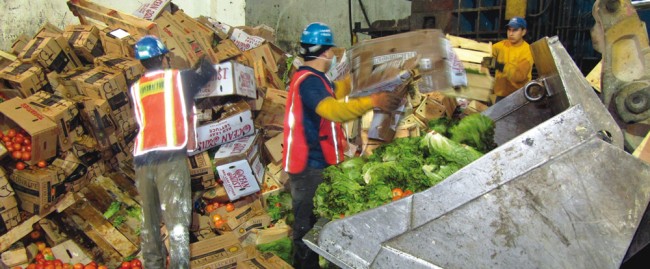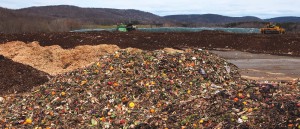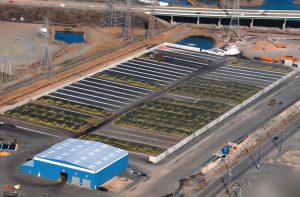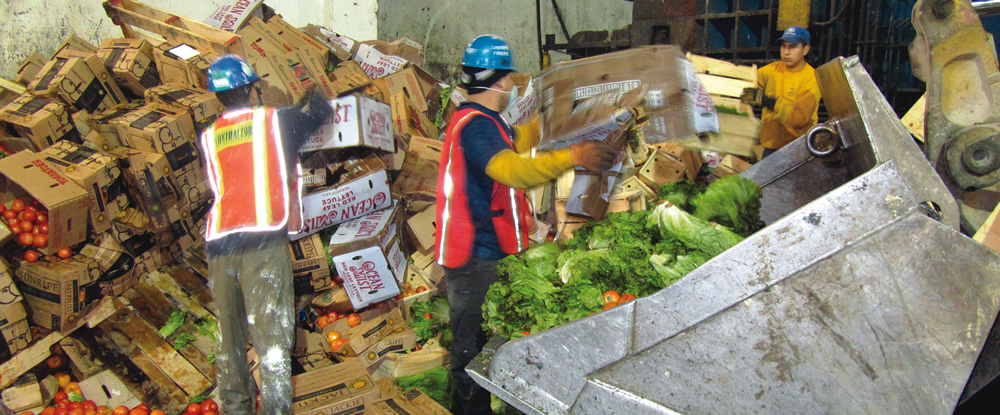Project by the Global Green USA’s Coalition for Resource Recovery is establishing design criteria that food waste recovery facilities must meet to be technically feasible, economically viable and environmentally sound.
Diane Greer
BioCycle December 2012, Vol. 53, No. 12, p. 41
Restaurants, hotels, colleges and universities, medical facilities and foodservice establishments in New York City generate about 1,640 tons/day of food waste each day, according to a Commercial Waste Management Study conducted by the city’s Department of Sanitation in 2004. A 2008 study by the New York City Department of Environmental Protection (DEP), based on preconsumer food waste only, estimated about 1,040 tons/day are generated (NYC DEP, 2008). Most of this material is sent to distant landfills. Less than six percent is recycled.
Global Green USA’s CoRR, the Coalition for Resource Recovery, is out to change this statistic through its Commercial Food Waste Recovery Program. Founded in 1993, Global Green USA is the American affiliate of Green Cross International, created by President Mikhail Gorbachev to foster a global value shift toward a sustainable and secure future. Global Green formed CoRR as an industry working group dedicated to combating climate change by generating business value through transforming waste recovery. The Commercial Food Waste Recovery Program aims to accelerate development of reliable, cost-effective and environmentally sound commercial food waste recovery infrastructure.

Sorters at a transfer station operated by Royal Waste in New York City remove contaminants from commercial food waste.
CoRR views New York City (NYC) as a good place to start evaluating alternative food waste recovery infrastructure. The cost of hauling waste to landfills is high and the magnitude of generators, which includes roughly 24,000 restaurant establishments, is huge. CoRR is focusing on commercial operations because that is where the largest amount of waste can be collected per stop. “We feel that if we could get greater collection on the commercial side that will influence the residential,” White says. “Essentially the residential can piggy back on top of the commercial in the future.”
Currently most commercial NYC food waste is commingled with other trash and collected by private haulers. By New York City law, private haulers can’t charge more then $208/ton to collect commercial putrescible waste (rate structures are set by NYC’s Business Integrity Commission). Based on conversations with four private haulers, CoRR estimates the average cost of collecting and disposing of commercial waste is $103 to $160/ton (more details in Cost Comparison section below). “That is the system we are seeking to beat,” White says.
A major component in the cost to recover food waste in NYC is proximity. Facilities that accept compostable packaging and levels of contamination deemed reasonable by haulers are 80 to 130 miles away (Table 1). Two closer facilities accept lower levels of contamination. Decreasing that distance would not only lower costs but also generate greater energy savings and reductions in greenhouse gas emissions.
Analysis Methodology
CoRR started its analysis by characterizing the commercial food waste stream in NYC. It used data from the 2008 NYC DEP study on the total amount of commercial food waste, and the average amount (by percentage) collected by venue. The study’s estimate of about 1,040 tons/day or higher only includes food waste from the “back of the house” (not postconsumer) at commercial operations. The breakdown, by venue, is as follows: restaurants and hotels (53%), other food service establishments (20%), retail food establishments (14%), medical facilities (9%), and colleges and universities (4%).

McEnroe Farms receives loads of separated food waste from New York City (100 mile distance), which it composts in windrows. The facility accepts meat waste and is able to take little to no contamination in incoming feedstocks.
Preliminary estimates of the level of contamination were determined for “back of house” and “front of house” environments through discussions with waste generators and facility operators. The level of contaminants plays into waste processing and infrastructure costs for various technology solutions. To assess the economics, scenarios analyzed assumed two different levels: 5 to 10 percent and 15 to 25 percent.
The next step identified potential sites for food waste recovery facilities for a financial analysis. An assumption was made that sites in New York City would be roughly five acres or less with appropriate zoning, based on land availability and costs. “M3” manufacturing districts were preferred. Sites in New Jersey were segmented into groups based on the distance from the city, i.e., within a 25-mile radius, 25 to 50-mile radius and so on.
Information was collected on average land values, electricity prices and the estimated price to haul waste to the sites to determine the tip fee required at each site to be competitive with the cost to landfill. For example, for new anaerobic digestion infrastructure in the city, the following market conditions were assumed: retail electricity: $0.21/kWh; wholesale electricity: <$0.03/kWh; average industrial real estate: $140/square foot. “Essentially we are creating a business plan and financial analysis,” says Matt de la Houssaye, Program Associate and Commercial Food Waste Recovery Program lead with Global Green USA. “We will likely model multiple scenarios for different levels of contamination, different debt structures and different costs of capital.” Quantifying the waste stream along with profiling site characteristics and economics will potentially help commercial developers analyze different technologies, such as composting and anaerobic digestion, that might fit the given conditions.
“We used capital and operations and maintenance costs from reference facilities in our models in order to determine internal rate of return and evaluate debt and cost of capital for potential projects,” explains de la Houssaye. “Using this as a starting point, we’re then evaluating financial viability based on value of recovered products, estimated tip fee that can be charged, and/or the value of incentives to meet the needed internal rate of return. We’re using data collected on reference facilities through university and municipal reports.”
CoRR also looked at current in-city transfer stations for potential siting opportunities since they are already permitted to handle putrescible waste. These transfer stations are permitted to receive on average over 500 tons/day/acre. There are opportunities to scale up and/or to add preprocessing facilities to existing transfer stations. Another option is to develop a new source separated transfer station. “We see a dedicated source separated organic transfer station as a way to maximize the ability to consolidate and preprocess or screen organic waste by having a dedicated space to conduct these activities,” says de la Houssaye. “This includes an opportunity to remove contaminants.” One transfer station operated by Royal Waste is handpicking waste out of the food residuals to reduce contamination levels prior to shipment to composting operations that are unable to handle high levels of contamination (see “Food Waste Diversion In Heart of Manhattan,” June 2012).

Peninsula Composting in Wilmington, Delaware has spare capacity of about 150 tons/day. The 260-mile round trip from NYC is estimated to cost haulers $500 to $1,000 in fuel and labor costs.
Initial Findings
An initial assessment of the information collected to date points to potential solutions along with areas for additional work and analysis. Table 2 summarizes scenarios for increasing food waste diversion for NYC’s commercial sector. CoRR has not yet completed the full economic modeling for the various options.
Peninsula Composting in Wilmington, Delaware, which is where some of NYC’s source separated food waste is taken, has spare capacity of about 150 tons/day. The Peninsula facility is the largest composting facility on the East Coast. The site is permitted to take up to 550 tons/day of food waste. The 260-mile round trip to Peninsula from NYC is estimated to cost haulers $500 to $1,000 in fuel and labor costs, about 25 percent of the total cost of tipping NYC’s food waste at this site. Depreciation and overtime pay are identified as two additional costs for shipping food waste this distance.
Five sites in New Jersey with a total of over 80-acres of industrial real estate were identified as representative sites within a 25-mile radius of the City. The sites may be appropriate for new regional composting facilities. CoRR estimates a new site could take between 200 to 550 tons/day of food waste.
Codigesting food wastes at four of the NYC’s WWTPs could divert 40 to 200 tons/day of material. The range is based on the initial and maximum processing capacity of the codigestion project at East Bay Municipal Utility District in Oakland, California, which is successfully codigesting food waste at its WWTP (see “Utility District Ramps Up Food Waste To Energy Program,” November 2011). This solution is appealing since it allows for incremental growth using existing infrastructure while reclaiming the energy in the waste. Preprocessing facilities, either on-site or at transfer stations, would be required to screen out contaminants prior to digestion.
Cost Comparisons
A discussion document written by White and de la Houssaye and released in September (de la Houssaye and White, 2012) compares the costs of current source separated food waste collection and composting options with the collection and disposal of municipal solid waste (MSW) containing putrescible waste. The NYC Department of Sanitation defines “putrescible waste” as the “portion of the solid waste stream containing organic matter having the tendency to decompose with the formation of malodorous by-products.” Since over 95 percent of commercial food waste generated in New York City is landfilled or disposed through a combustion process (as a part of unsorted MSW), White and de la Houssaye felt it was important to understand the economics of this system in order to determine how it relates to and compares with food waste collection and recovery.
Cost estimates used in this document were based on results from the analyses summarized above and included CoRR’s survey of waste industry haulers, brokers, composters and vehicle manufacturers. Ranges were provided to account for the variation in survey responses. The cost per ton for the collection, transport and disposal of commercial MSW (containing putrescible waste) was based on the scenario of in-city collection by a waste hauler and tipping at an in-city commercial waste transfer station. Using these assumptions, costs from collection to ultimate disposal at a landfill or waste to energy facility were included. The objective is to provide an estimate that is within the “ballpark” of the industry average and to provide relative cost comparisons with source separated organics collection, transport and recovery.
Tables 3 and 4 summarize the assumptions used. For example, to calculate in-city collection costs, a range of $75 to $100/hour, or $600 to $800/8-hour shift, was assumed to collect 10 to16 tons/shift of commercial, unsorted waste. Conversely, an 8-hour collection route for food waste would yield 8 to 16 tons/shift. Table 4 summarizes the cost comparisons. For in-city collection of unsorted waste the rate is $38 to $80/ton. The New York City commercial waste transfer station tip fee is estimated to be $65 to $80/ton. This cost includes the handling of the material at the transfer station, shipping it to landfill, and the landfill tip fee. Adding the in-city tip fee to the cost of collection of $38 to $80 previously mentioned yields a total cost of $103 to $160/ton for unsorted commercial waste. And as noted earlier, the maximum price waste haulers can charge in New York City is $208/ton.
The Peninsula Compost facility in Wilmington was chosen as a comparison to landfill. This facility is preferred by some haulers collecting from restaurants and grocers since the facility has highway access, accepts compostable packaging, and is able to handle lower food waste stream purity levels, write de la Houssaye and White in their discussion document. To calculate costs of in-city collection by truck, a cost range of $75 to $100/hour, or $600 to $800/8-hour shift, was assumed. If 8 to 16 tons are collected per shift, in-city collection from commercial entities will cost $38 to $100/ton.
Two options were evaluated for sending food waste to the Peninsula facility (located approximately 130 miles from NYC). Both options are currently practiced by NYC haulers. The first is for food waste to be sent to a NYC transfer station, consolidated into a long-haul truck (capacity of 20 tons), and taken to Peninsula. Shipping costs of sending food waste to Peninsula Compost by long-haul truck were estimated by survey respondents in dollars/mile. The transfer station handling cost was estimated at $4 to $10/ton. A tip fee of $45 to $50/ton at Peninsula was used based on the literature and a discussion with one of the facility’s cofounders. Food waste also is sent directly to Peninsula in garbage trucks. This cost is estimated using the reported price range for garbage collection of $75 to $100/hour. The calculations considered the lifespan of a garbage truck versus the long-haul truck for the 260-mile trip (Table 3). Based on both scenarios, estimates for hauling fees for curbside food waste collection may range from $113 to $233/ton, placing the upper range above the New York City rate cap of $208/ton.
De la Houssaye and White’s discussion document indicates that the high-end estimates for in-city collection of organics can be $20/ton more than unsorted commercial waste collection. This difference is due to the amount of organics collected per shift with 8 to 16 tons/night being cited for organics collection compared to 10 to 16 tons/night for commercial putrescible waste. The document concludes by suggesting potential efficiencies in materials handling and collection. These include use of a split body truck to enable collection with recyclables or trash; increase route density and/or the volume of organics collected per stop; and decrease collection frequency. Another suggestion is to reduce transport distance to processing locations. “Twenty-three to 36 percent of the total cost of sending organic waste from New York City to Peninsula Compost is due to long-haul transport,” write de la Houssaye and White. “Reducing this distance, while maintaining a cost-competitive tip fee, is one way to increase the cost-competitiveness of source separated organics collection and recovery.”
Download pdf:
Economics of New York City Commercial MSW Collection & Disposal and Source-Separated Food Waste Collection & Composting: Opportunities to Reduce Costs of Food Waste Collection & Recovery
Diane Greer is a Contributing Editor to BioCycle. For more information and to download reports cited, go to www.thecorr.org/programsfoodwaste.php.










